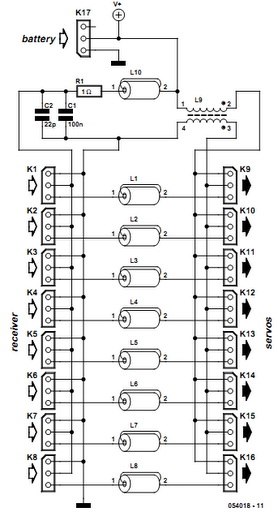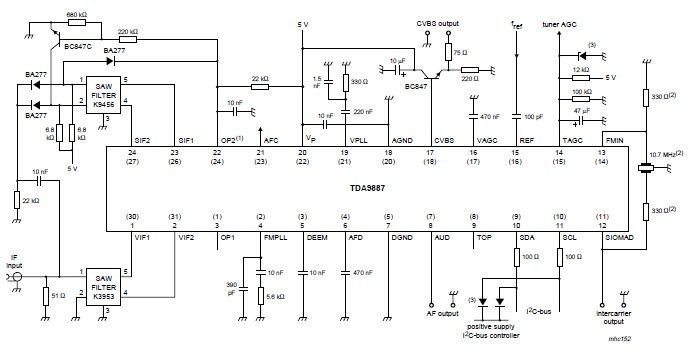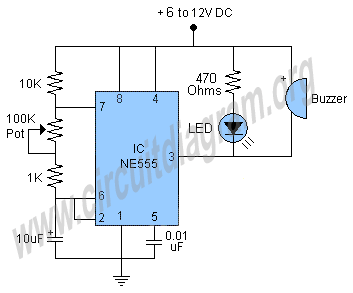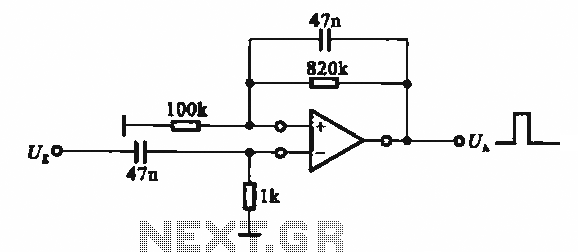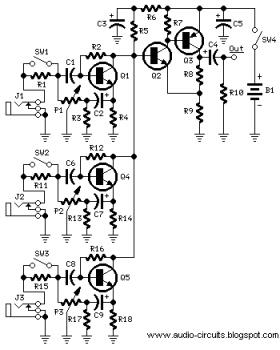
Visible-Light Receiver Circuit
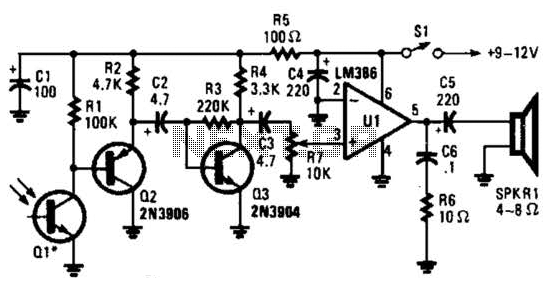
This receiver for amplitude-modulated light signals utilizes a phototransistor Q1 mounted within a parabolic reflector to enhance its range. Any NPN phototransistor is suitable for this application. An emitter-follower configuration using Q2 drives an amplifier stage Q3. The output from Q3 is directed to a volume control resistor R7, followed by an audio amplifier U1. A power supply voltage of 9 to 12 volts is recommended for optimal operation of the receiver.
The described circuit operates by detecting amplitude-modulated light signals, which are typically generated by an infrared LED or similar light source. The phototransistor Q1 serves as the primary sensing element, converting the incoming light signals into electrical current. The parabolic reflector enhances the effective range by directing more light onto the phototransistor, thus improving sensitivity and performance in various lighting conditions.
The emitter-follower transistor Q2 is configured to provide impedance matching between the phototransistor and the subsequent amplifier stage. This configuration ensures that the output from Q1 can drive Q3 effectively, allowing for a stronger signal to be amplified. The amplifier Q3 is crucial for boosting the weak signals received from the phototransistor to a level suitable for processing.
Following amplification, the output signal is passed through a volume control resistor R7, allowing for user adjustment of the audio output level. This control is essential for tailoring the listening experience to the user's preference and ensuring that the audio signal is not too loud or too soft.
Finally, the audio amplifier U1 is responsible for driving the speaker or headphones, converting the amplified electrical signals into audible sound. The recommended power supply voltage range of 9 to 12 volts ensures that all components operate within their specified limits, providing reliable performance and longevity for the receiver circuit.
This circuit design is versatile and can be adapted for various applications, including wireless audio transmission systems, remote control devices, and other light-based communication systems. This receiver for amplitude-modulated light signals uses phototransistor Ql mounted in a parabolic reflector (to increase range). Any npn phototransistor should work. Emitter-follower Q2 drives amplifier Q3. The output from Q3 feeds volume control R7 and audio.amplifier Ul. A 9- to 12-V supply is recommended for the receiver.
The described circuit operates by detecting amplitude-modulated light signals, which are typically generated by an infrared LED or similar light source. The phototransistor Q1 serves as the primary sensing element, converting the incoming light signals into electrical current. The parabolic reflector enhances the effective range by directing more light onto the phototransistor, thus improving sensitivity and performance in various lighting conditions.
The emitter-follower transistor Q2 is configured to provide impedance matching between the phototransistor and the subsequent amplifier stage. This configuration ensures that the output from Q1 can drive Q3 effectively, allowing for a stronger signal to be amplified. The amplifier Q3 is crucial for boosting the weak signals received from the phototransistor to a level suitable for processing.
Following amplification, the output signal is passed through a volume control resistor R7, allowing for user adjustment of the audio output level. This control is essential for tailoring the listening experience to the user's preference and ensuring that the audio signal is not too loud or too soft.
Finally, the audio amplifier U1 is responsible for driving the speaker or headphones, converting the amplified electrical signals into audible sound. The recommended power supply voltage range of 9 to 12 volts ensures that all components operate within their specified limits, providing reliable performance and longevity for the receiver circuit.
This circuit design is versatile and can be adapted for various applications, including wireless audio transmission systems, remote control devices, and other light-based communication systems. This receiver for amplitude-modulated light signals uses phototransistor Ql mounted in a parabolic reflector (to increase range). Any npn phototransistor should work. Emitter-follower Q2 drives amplifier Q3. The output from Q3 feeds volume control R7 and audio.amplifier Ul. A 9- to 12-V supply is recommended for the receiver.

